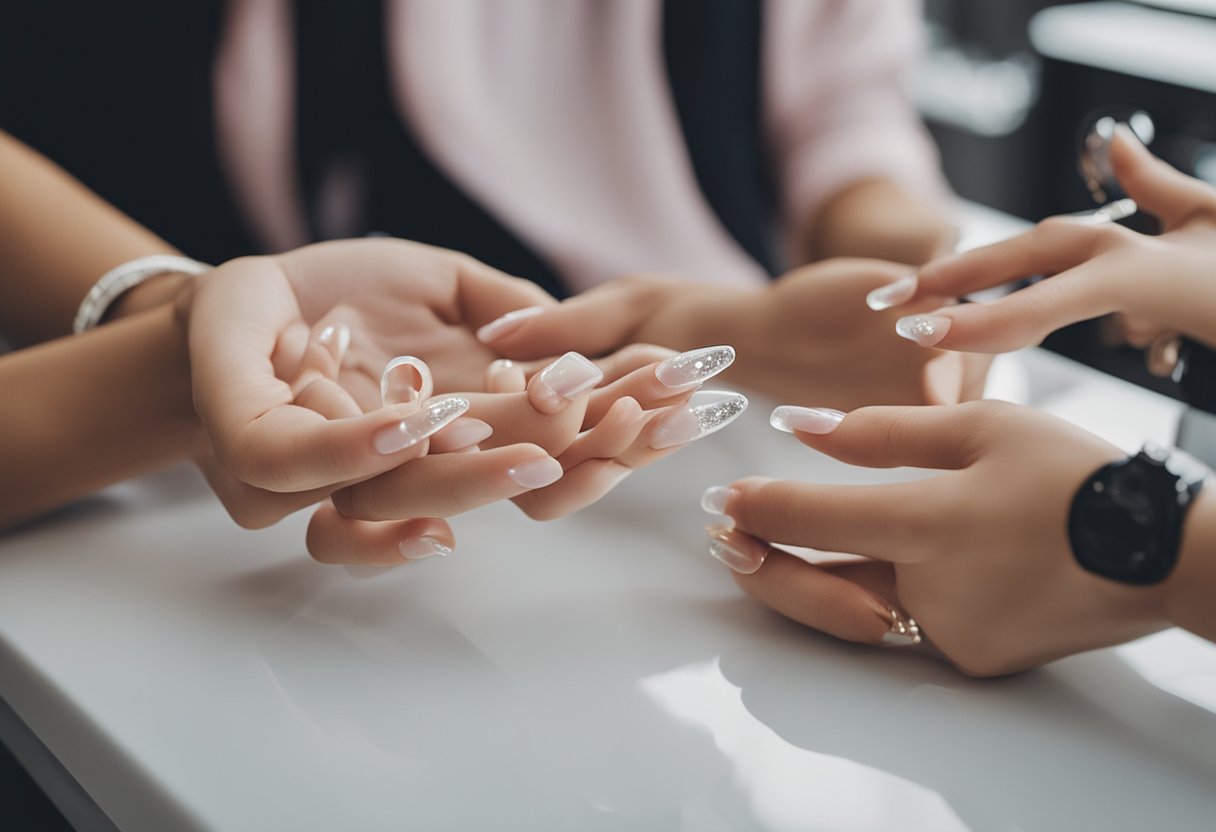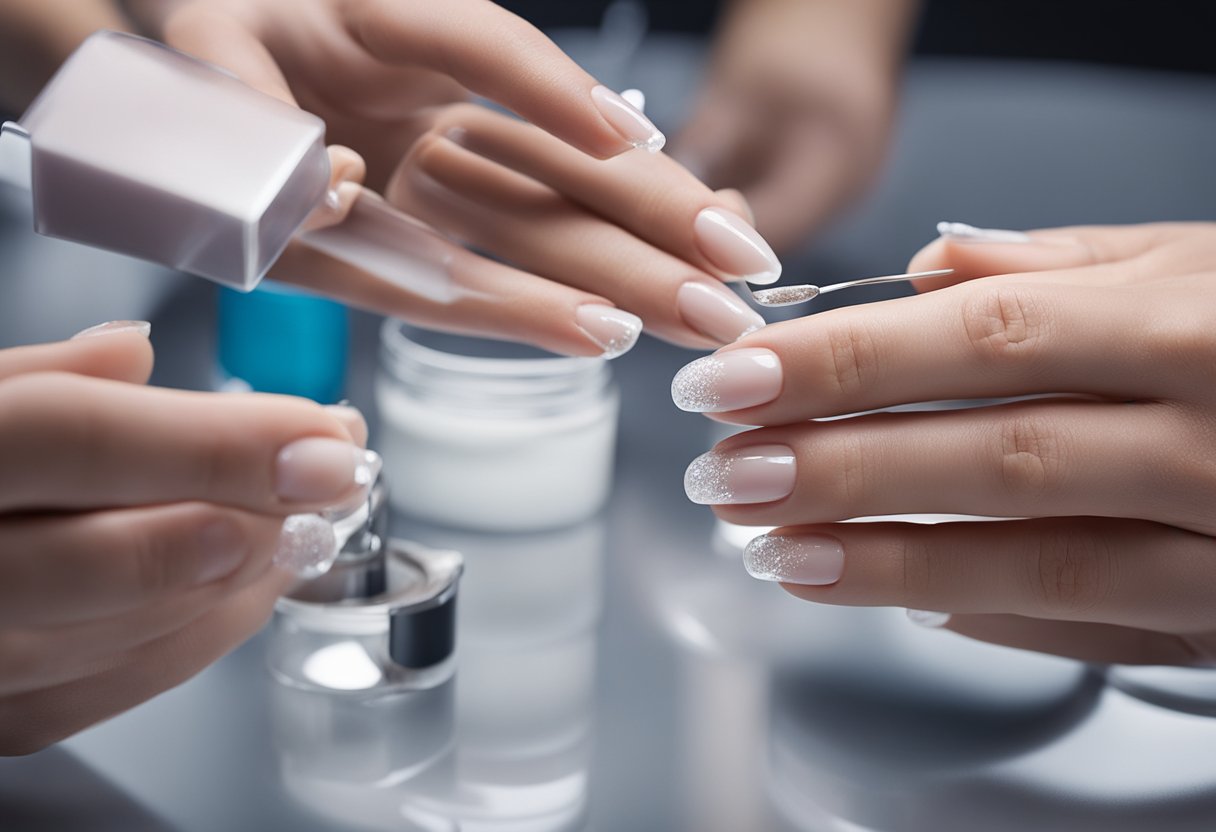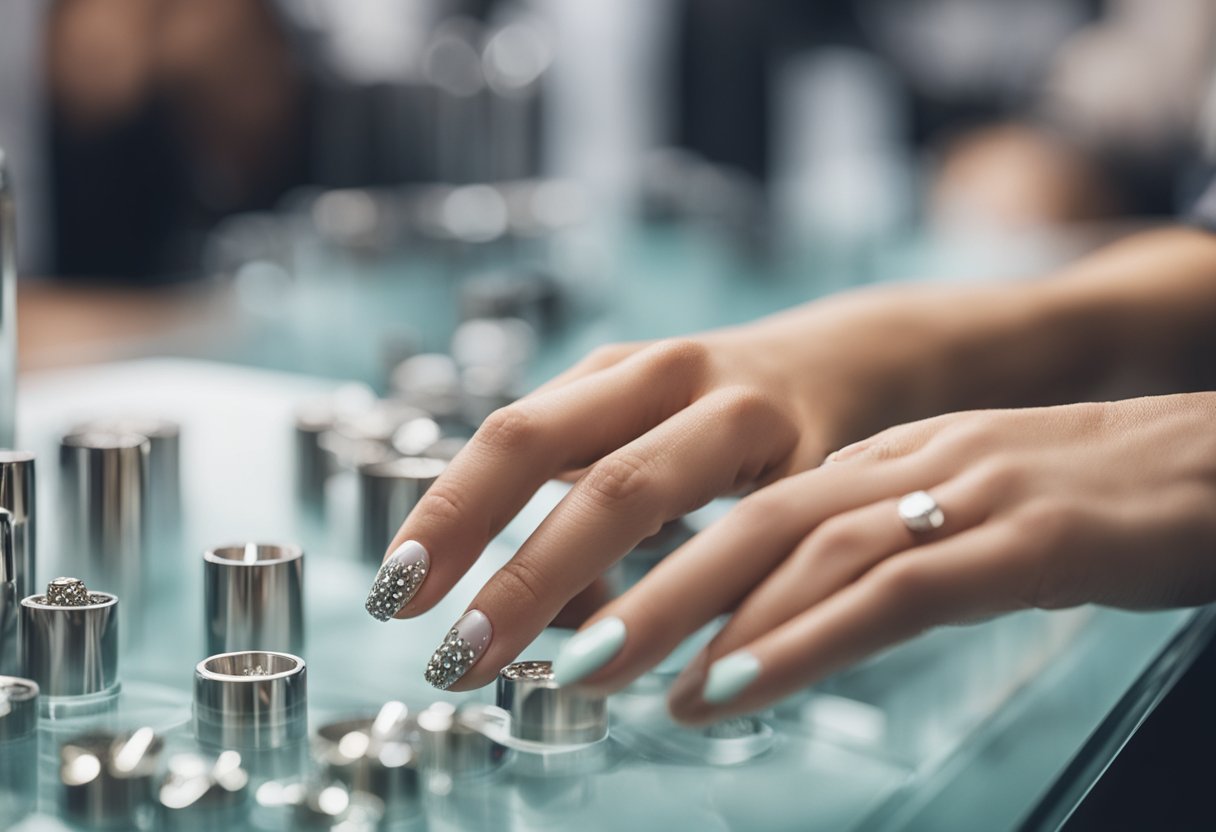As someone who enjoys getting their nails done, you may be wondering how old you should be to get acrylic nails. Acrylic nails are a popular beauty trend that can make your nails look longer, stronger, and more polished. However, there are age considerations to keep in mind before getting acrylic nails.

Understanding acrylic nails is important before deciding if they are right for you. Acrylic nails are made from a type of plastic called polymethyl methacrylate (PMMA), which has been used in various beauty products for many years. While there is always a risk of infection when getting any type of nail treatment, the risk is relatively low with acrylic nails. However, it is important to consider your age before getting acrylic nails.
Key Takeaways
- Age considerations are important when deciding to get acrylic nails.
- The minimum age for getting acrylic nails varies by country and salon policies.
- It is recommended to keep acrylic nails short for those under the age of 16.
Understanding Acrylic Nails

As someone who has been in the beauty industry for many years, I can tell you that acrylic nails are a popular form of nail enhancement. Acrylic nails are made of a liquid and powder combination that is applied to the nails and shaped to create a long and durable nail.
There are two types of acrylic nails: traditional and sculptured. Traditional acrylic nails are created by applying a tip to the natural nail and then applying the acrylic mixture to the tip and nail. Sculptured acrylic nails, on the other hand, are created by using a form that is placed under the natural nail and then applying the acrylic mixture to the form.
Acrylic nails come in different forms, including clear, French, and colored. Clear acrylic nails are transparent and can be painted any color. French acrylic nails have a white tip and a clear base, while colored acrylic nails come in a variety of colors.
It is important to note that acrylic nails are not for everyone. If you have weak or brittle nails, it is best to avoid acrylic nails as they can cause further damage. Additionally, if you are under the age of 16, some salons may refuse to apply acrylic nails to you. While there are no legal age requirements for acrylic nails, most salons prefer to apply them to those who are at least 16 years old, as this is the age when most people have mature nail beds that are better able to support the application and upkeep of acrylic nails.
Overall, acrylic nails are a great way to enhance the look of your nails and create a long-lasting manicure. However, it is important to understand the different types and forms of acrylic nails, as well as their limitations, before deciding if they are right for you.
Age Considerations for Acrylic Nails

As a nail technician, I am often asked about the appropriate age to get acrylic nails. The answer is not straightforward, as it depends on several factors. Here are some considerations to keep in mind:
Maturity and Responsibility
First and foremost, getting acrylic nails requires a certain level of maturity and responsibility. The client must be able to take care of their nails properly, which includes regular maintenance appointments and avoiding activities that could damage the nails. As a general rule of thumb, I recommend that clients be at least 16 years old before getting acrylic nails. At this age, most people have mature nail beds that can better support the application and upkeep of acrylic nails.
Legal Age and Age Limit
In terms of legal age, there is no age limit whatsoever on acrylic nails. However, some salons may have their own age restrictions. For example, some salons may refuse to apply acrylic nails to anyone under 16 years old or require parental consent for minors. It is important to check with local salons or the state licensing board for the specific regulations in your area.
Special Occasions
While 16 is a good age to start getting acrylic nails, some younger clients may want them for special occasions such as prom or a wedding. In these cases, it is recommended to keep the nails short and avoid any activities that could damage them. It is also important to note that acrylic nails are not recommended for children under 13 years old.
In conclusion, the appropriate age to get acrylic nails depends on several factors such as maturity, responsibility, and age restrictions set by salons. As a nail technician, I recommend that clients be at least 16 years old before getting acrylic nails, but younger clients may get them for special occasions with proper care and maintenance.
The Process of Getting Acrylic Nails

As someone who has been getting acrylic nails for years, I can confidently say that the process of getting acrylic nails is not difficult. However, it is important to go to a reputable salon and a skilled nail technician to ensure that the process is done correctly.
First, the nail technician will prepare your nails by cleaning and buffing them. Then, they will apply a primer to your nails to help the acrylic adhere better. Next, they will apply a tip to the end of your nail if you want to extend the length of your nail. The tip is glued to your nail and then trimmed to the desired length.
After the tip is applied, the nail technician will mix the acrylic powder and liquid monomer to create a paste. They will then use a brush to apply the paste to your nails, starting at the base of the nail and working their way to the tip. The paste will harden in a few minutes, and the nail technician will file and shape your nails to your desired length and shape.
Finally, you can choose to have nail art or polish applied to your nails. The nail technician will apply a top coat to protect your nails and help them last longer. It is important to note that acrylic nails require maintenance every two to three weeks to fill in any gaps that may have formed as your nails grow.
Overall, the process of getting acrylic nails is straightforward and can be done in a relatively short amount of time. However, it is important to go to a reputable salon and a skilled nail technician to ensure that the process is done correctly and safely.
Potential Risks and Concerns

As with any beauty treatment, there are potential risks and concerns associated with getting acrylic nails. It is important to be aware of these risks before deciding to get acrylic nails.
One of the biggest concerns with acrylic nails is the potential damage they can cause to your natural nails. Acrylic nails can make your natural nails thin and brittle, which can lead to breakage and other damage. Additionally, the harsh chemicals used in the application and removal of acrylic nails can cause irritation and damage to the skin surrounding the nails.
Another concern with acrylic nails is the risk of infection. Bacteria and fungal infections can develop if the nail technician does not properly sanitize their tools or if the acrylic nails are not properly cared for. It is important to choose a reputable salon and nail technician who follows proper sanitation practices.
In rare cases, some people may have an allergic reaction to the chemicals used in acrylic nails. Symptoms of an allergic reaction can include redness, itching, and swelling of the skin surrounding the nails. If you experience any of these symptoms, it is important to seek medical attention.
Overall, while acrylic nails can be a fun and fashionable way to enhance your look, it is important to be aware of the potential risks and concerns associated with them. By choosing a reputable salon and nail technician, properly caring for your acrylic nails, and being aware of any symptoms of infection or allergic reaction, you can safely enjoy the beauty benefits of acrylic nails.
Care and Maintenance of Acrylic Nails
As someone who has had acrylic nails for many years, I can attest to the importance of proper care and maintenance. Here are some tips to keep your acrylic nails looking great:
1. Keep Them Clean
It’s important to keep your acrylic nails clean to prevent bacteria and fungus from growing underneath them. Use a soft-bristled brush and warm, soapy water to clean your nails regularly. Avoid using harsh chemicals or abrasive tools that can damage the acrylic.
2. Moisturize Your Cuticles
Keeping your cuticles moisturized is essential to maintaining healthy nails. Apply cuticle oil to your nails and cuticles daily to prevent them from drying out and becoming brittle. This will also help prevent hangnails and other nail problems.
3. Avoid Harsh Chemicals
Acrylic nails are strong, but they can still be damaged by harsh chemicals found in cleaning products, nail polish remover, and other beauty products. When using these products, wear gloves to protect your nails.
4. Get Regular Manicures
Regular manicures are a great way to keep your acrylic nails looking their best. A professional manicure will help to maintain the shape and length of your nails and keep them looking shiny and healthy.
5. Be Careful with Nail Polish
While acrylic nails are strong, they can still be damaged by nail polish. Avoid using nail polish that contains harsh chemicals, and always use a top coat to protect your nails from chipping and peeling. If you want to remove your nail polish, use a non-acetone nail polish remover.
6. Consider Gel Nail Polish
Gel nail polish is a great alternative to traditional nail polish because it is long-lasting and less likely to chip or peel. It also dries quickly and is less damaging to your nails than traditional nail polish. If you want to try gel nail polish, be sure to go to a salon that specializes in gel nails.
By following these tips, you can keep your acrylic nails looking great and maintain good nail health. Remember to always be gentle with your nails and avoid doing anything that could damage them.
Alternatives to Acrylic Nails
As an expert in nail care, I always advise my clients to consider alternative options to acrylic nails. While acrylic nails may look great, they can cause damage to your natural nails over time. Here are some alternatives that you may want to consider:
Press-On Nails
Press-on nails are a great alternative to acrylic nails. They come in a variety of colors and styles, and they are easy to apply. Unlike acrylic nails, press-on nails do not require any harsh chemicals or drills to apply. They are also much easier to remove than acrylic nails.
Stickers
Nail stickers are another great alternative to acrylic nails. They come in a variety of designs and colors, and they are easy to apply. Unlike acrylic nails, nail stickers do not require any harsh chemicals or drills to apply. They are also much easier to remove than acrylic nails.
Gel Polish
Gel polish is a great alternative to acrylic nails. It is a type of nail polish that is cured under a UV light. It is very durable and can last up to two weeks without chipping. It also comes in a variety of colors and styles, and it gives your nails a natural look.
Natural Look
If you want a natural look, you can always go with your natural nails. You can keep them short and clean, or you can grow them out and apply a clear coat of nail polish. This is a great option if you want to give your nails a break from acrylic nails.
In conclusion, there are many alternatives to acrylic nails that you can consider. Whether you choose press-on nails, stickers, gel polish, or a natural look, you can still have beautiful nails without damaging your natural nails.
Cost and Other Considerations

When considering getting acrylic nails, there are several factors to keep in mind. One of the most important considerations is the cost. The cost of acrylic nails varies depending on the location, services offered, and the level of experience of the nail technician. On average, the cost of a full set of acrylic nails can range from $30 to $80, while a fill-in can cost anywhere from $20 to $60. It is important to keep in mind that the cost of acrylic nails is a recurring expense, as they require maintenance every few weeks.
Another important consideration is the commitment required to maintain acrylic nails. Acrylic nails require regular upkeep, including fill-ins and repairs. It is also important to avoid certain activities that could damage the nails, such as using them to open cans or bottles. If you are someone who enjoys activities such as gardening or playing sports, acrylic nails may not be the best option.
Acrylic nails are often chosen for special occasions, such as weddings or proms. If you are considering getting acrylic nails for a special occasion, it is important to plan ahead and schedule an appointment in advance. It is also important to communicate your needs and preferences with the nail technician to ensure that you are happy with the final result.
When choosing a nail salon to get acrylic nails, it is important to consider the location and the services offered. Look for a salon that is conveniently located and offers a range of services, such as nail art and other treatments. It is also important to check the salon’s policy on refunds and support in case of any issues or concerns.
In conclusion, getting acrylic nails can be a great way to enhance your appearance and feel more confident. However, it is important to consider the cost, commitment, activities, special occasions, location, services, policy, and support before making a decision. By doing your research and choosing a reputable salon, you can ensure that you are happy with the final result.
Frequently Asked Questions

What is the minimum age requirement for getting acrylic nails?
The minimum age requirement for getting acrylic nails varies by country. In the United States, some states have specific laws or regulations regarding the minimum age for receiving nail services, while others rely on individual salon policies or parental consent. Some salons require written consent from a parent or guardian. According to Acrylicpedia, the minimum age for getting acrylic nails is usually 16 years old while some countries have a minimum age of 18 years.
Is it safe for a 10-year-old to get acrylic nails?
There is no definitive answer to this question since there is no one-size-fits-all answer when it comes to beauty treatments. However, according to Bellatory, acrylic nails are not recommended for children under the age of 12. Children’s nails are still developing, and the chemicals used in the process of applying acrylic nails can damage the nail bed and stunt the growth of the natural nails.
Should I allow my 11-year-old to get acrylic nails?
It is recommended to wait until your child is at least 12 years old before allowing them to get acrylic nails. According to Bellatory, children’s nails are still developing, and the chemicals used in the process of applying acrylic nails can damage the nail bed and stunt the growth of the natural nails. It is important to consider the potential risks and weigh them against the desire for a cosmetic treatment.
Can a 12-year-old get acrylic nails?
Yes, a 12-year-old can get acrylic nails. According to Lovely Nails and Spa, acrylic nails are typically appropriate for people aged sixteen and up, although some may choose to get them as young as thirteen for special occasions. If someone younger than sixteen gets acrylics, it is recommended to keep them short.
Can a 13-year-old get acrylic nails?
Yes, a 13-year-old can get acrylic nails. However, it is important to consider the potential risks and weigh them against the desire for a cosmetic treatment. According to Lovely Nails and Spa, acrylic nails are typically appropriate for people aged sixteen and up, although some may choose to get them as young as thirteen for special occasions. If someone younger than sixteen gets acrylics, it is recommended to keep them short.
What are the risks of getting acrylic nails at a young age?
Getting acrylic nails at a young age can have potential risks. According to Bellatory, children’s nails are still developing, and the chemicals used in the process of applying acrylic nails can damage the nail bed and stunt the growth of the natural nails. Additionally, if the acrylic nails are not applied properly or maintained correctly, they can lead to infections or other nail problems. It is important to consider the potential risks and weigh them against the desire for a cosmetic treatment.

Hi, I’m Sal Muller of Tooltrip.com. My DIY experience led me to understand essential power tools for home projects. Tooltrip.com guides enthusiasts and professionals in choosing right tools for any job. I provide concise top tool reviews for easier, efficient DIY.

